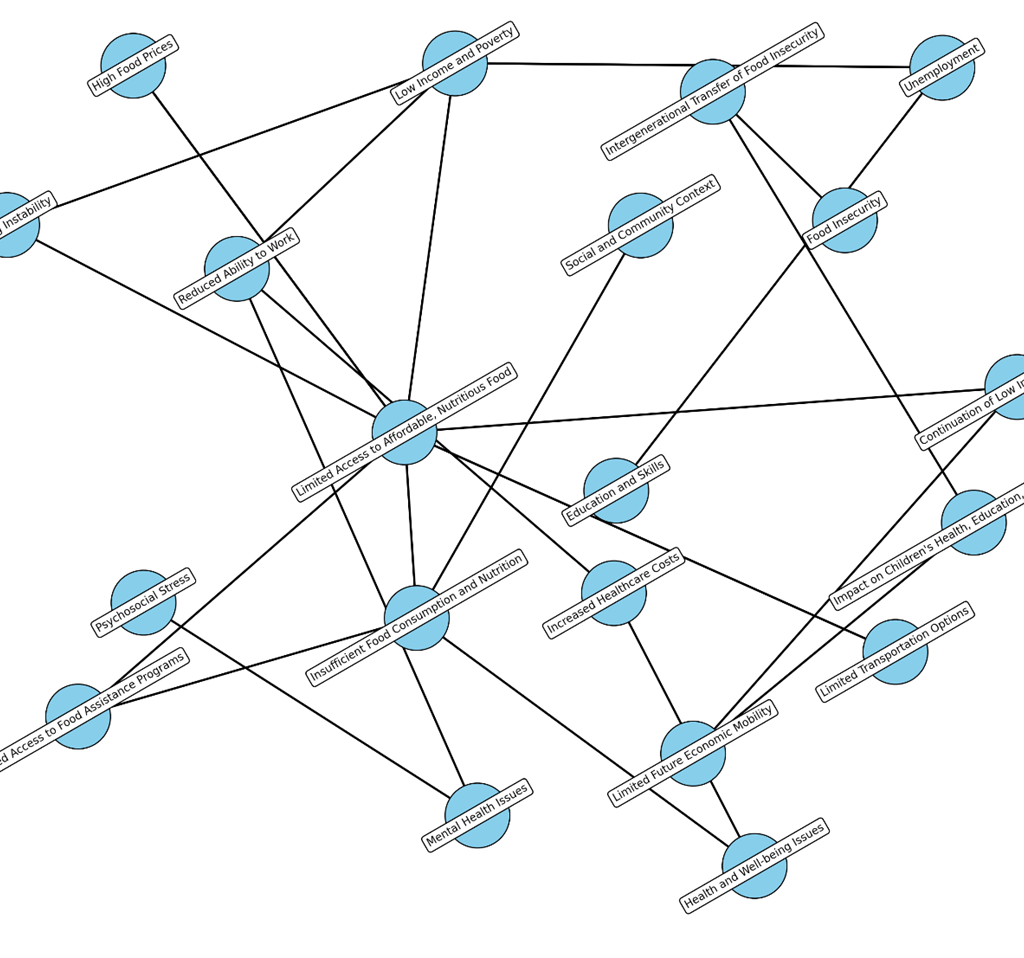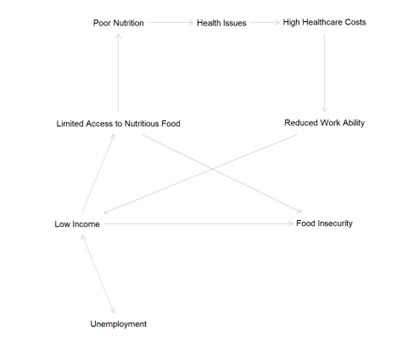Jennifer Carpenter, PhD Student
PhD Candidate, Nutrition Epidemiology and Data Science, Friedman School of Nutrition Science and Policy, Tufts University
Final Presentation
Final Project
Artificial Intelligence and Health of U.S. Military Veterans Future implications in Food Insecurity
Project Description
Abstract
Food insecurity disproportionately impacts U.S. military veterans compared to Americans with no history of military service. It is proposed that increased risk of food security is related to increased risk of physical disabilities, mental health challenges, homelessness, and difficulties transitioning from the military to civilian workforce. Researchers have demonstrated that artificial intelligence can be utilized to predict individuals at high risk for food insecurity; however, this has not been replicated in a Veteran population. This study aims to utilize machine learning techniques to analyze data from the 2011-2018 National Health and Nutrition Examination Survey (NHANES). Specifically, we will reverse engineer responses to the NHANES food insecurity supplement questionnaires. In doing so, we anticipate that we will create a decision tree that utilizes sociodemographic and minimally intrusive data to predict likelihood of food insecurity among Veterans. The outcomes of this study will facilitate the development of targeted interventions aimed at preventing food insecurity in vulnerable Veteran populations.
Introduction and Rationale
Veterans are a generally under-researched, vulnerable population whose representative ‘face’ is continuously evolving and reflective of regional and national political views, economic opportunities, military sympathies, recruitment strategies, and current events, amongst other factors. As time continues, veterans are becoming younger and more diverse. Current systems and policies to support veteran reintegration into the civilian workforce and address major concerns impacting veteran health such as substance abuse, post-traumatic stress disorder, and an array of insecurities, including food insecurity, are threatened by inadequate research and resources.
Recent headlines have demonstrated that veterans experience food insecurity at a greater rate than previously thought, legitimizing concerns that veterans face ongoing threats to basic needs and the inherent human rights to adequate food, water, and shelter. As food insecurity is referenced more in the context of veterans, there are inherent risks that food insecurity will become synonymous with veterans and food insecurity in veterans will become a normalized stereotype, which may decrease the call to action for policy makers to address this major societal concern.
For this reason, I intend to create a use case to evaluate how the determinants of health, including sociodemographics and the social, commercial, and political determinants of health, interact with food security in the veteran population. By utilizing artificial intelligence to analyze publicly available datasets, including NHANES, Census-ACS data, WIC data, and Veteran Employment Opportunities data, I can optimize machine learning and predictive analytic modeling to predict veterans at the greatest risk for food insecurity. In doing so, this will inform decision makers to create policy that provides appropriate and timely preventative interventions for food insecurity in veterans.
Literature Review
In the past decade, the United States has experienced declining economic conditions and increased food prices that have drastically influenced the costs of living for all Americans. These changes have had the most severe impacts on the most economically vulnerable Americans. In concert with this, there have been increasing reports that food insecurity is experienced at a greater rate in the U.S. military veteran population than in the non-military veteran population. Although there are drastic differences in reported rates of food insecurity ranging from 6% to 20% of veterans face food insecurity, there have also been increased surveying and improved societal awareness of food insecurity that enables veterans and all vulnerable populations more likely to admit that they are experiencing food insecurity and request assistance.
Food insecurity is defined as a limited or uncertain access to adequate food. It is typically measured using the United States Department of Agriculture (USDA) 18-item Household Food Security Survey Module or the 6-item short form. More recently, surveys including the Hunger Vital Signs, which is a two question screener, are being utilized to assess food insecurity. Food insecurity is associated with poor physical and mental health, economic impacts, and epigenetic consequences that worsen the outcomes related to cycles of poverty and poor health.
Veterans may experience food insecurity at a greater rate compared with non-military veterans related to increased risk of service connected concerns. Although research typically highlights the cost of veteran status relevant to physical disabilities, mental health challenges, and homelessness, the costs of military service extend far beyond these. Veterans also face difficulties with transitioning from the military to civilian workforce, difficulties with optimal spousal earning potential, have lower earning potential related to fewer transferable skills from military job, decreased social support and lower education levels. Beyond this, veterans may be more susceptible to societal stigma and lack of awareness of food assistance programs.
Although most historic research and policy outlines the risks of food insecurity or other insecurities in older and disabled veterans, more recent research has highlighted food insecurity may be more prevalent in other veteran demographics. These include low-income veterans, veterans with dependents, female veterans, minority veterans, young veterans, and rural veterans.
Artificial intelligence and machine learning has previously been utilized to predict food insecurity in the general population; however, there is a significant gap in applying machine learning to veteran populations. There are a multitude of opportunities to utilize artificial intelligence techniques to address these problems, including random forests, neural networks, support vector machines, clustering algorithms, natural language processing, reinforcement learning, Bayesian networks and explainable artificial intelligence.
Although opportunities for research advancement are numerous, it is limited by representative data sets and research that has been specifically conducted in veteran populations. These data sets are limited, generally publicly unavailable and selectively utilized to explore relationships that may not elucidate the delicate interweaving of individual, societal, and military-service connected factors.
We intend to optimize our use case to expand the study of food insecurity within the veteran population to better predict factors influencing food insecurity in veterans.
Use Case Description
The goal of this project is to understand the complex relationships between food insecurity and the social determinants of health, such as low income, unemployment, education, housing instability, and health issues. By using a causal diagram (DAG), we aim to identify key pathways and mediators that contribute to food insecurity and develop targeted interventions to mitigate these issues.
Objectives
- Identify Key Determinants: Understand how various social determinants contribute to food insecurity.
- Analyze Pathways: Use a causal diagram to map out the pathways and identify mediators, confounders, and colliders.
- Develop Interventions: Design targeted interventions based on the identified pathways to reduce food insecurity.
- Policy Recommendations: Provide evidence-based policy recommendations to stakeholders and policymakers.
Stakeholders
- Community Members: Individuals and families experiencing food insecurity.
- Healthcare Providers: Medical professionals addressing health issues related to poor nutrition.
- Policy Makers: Government officials responsible for social welfare and public health policies.
- Nonprofit Organizations: Organizations working to alleviate poverty and food insecurity.
- Researchers and Academics: Experts studying the social determinants of health and food insecurity.
Steps and Methodology
- Data Collection:
- Surveys and Interviews: Collect data from individuals experiencing food insecurity to understand their challenges and the factors contributing to their situation.
- Secondary Data Analysis: Use existing data from public health records, census data, and social services to identify patterns and correlations.
- Causal Diagram Construction:
- Identify Variables: Determine key variables such as low income, unemployment, education, housing instability, limited access to nutritious food, poor nutrition, health issues, high healthcare costs, and reduced work ability.
- Define Relationships: Map out the causal relationships between these variables using R studio, DAGitty or other DAG software.
- Analysis:
- Identify Mediators, Confounders, and Colliders: Analyze the causal diagram to identify mediators (e.g., limited access to nutritious food), confounders (e.g., socioeconomic status), and colliders (e.g., reduced work ability).
- Pathway Analysis: Determine the key pathways through which low income leads to food insecurity and poor health outcomes.
- Intervention Design:
- Targeted Programs: Develop programs aimed at improving access to nutritious food, increasing employment opportunities, providing education and skills training, and addressing health issues.
- Pilot Projects: Implement pilot projects in selected communities to test the effectiveness of these interventions.
- Policy Recommendations:
- Evidence-Based Policies: Based on the findings, recommend policies that address the root causes of food insecurity, such as increasing the minimum wage, improving access to education, and expanding healthcare services.
- Stakeholder Engagement: Present the recommendations to policymakers, community leaders, and other stakeholders to gain support and drive policy changes.
Expected Outcomes
- Improved Understanding: A comprehensive understanding of the factors contributing to food insecurity and the pathways through which they operate.
- Effective Interventions: Development and implementation of targeted interventions that address the key determinants of food insecurity.
- Policy Changes: Adoption of evidence-based policies that mitigate the impact of social determinants on food insecurity.
- Community Empowerment: Empowerment of communities through improved access to resources and support services.
Monitoring and Evaluation
- Continuous Monitoring: Regularly monitor the implemented interventions to assess their effectiveness and make necessary adjustments.
- Impact Assessment: Conduct periodic evaluations to measure the impact of interventions on food insecurity and related health outcomes.
- Feedback Mechanisms: Establish feedback mechanisms to gather input from community members and other stakeholders on the interventions and their outcomes.
Knowledge Graphs and Conceptual/Causal Diagrams
Figure 1 outlines the key relationships between food insecurity and the social determinants of health. This knowledge graph outlines everything that is presently known regarding relationship between food insecurity and social determinants of health. This figure is essential in providing context to the complex inner relationships between variables and demonstrate the difficulties associated with simplifying and under contextualizing relationships in an increasingly complex world.
Figure 2 provides a simplified directed acyclic graph (DAG) or causal diagram of the relationship between food insecurity, income, health and employment factors. Figure 2 demonstrates the influence of mediators and colliders within the context of food insecurity. There are several mediators, or variables that lie on the causal pathway and explain part of the mechanism through which the effect occurs. Limited access to nutritious food mediates the pathway between low income and poor nutrition; poor nutrition mediates the pathway between limited access to nutritious food and health issues; health issues mediates the pathway between poor nutrition and high healthcare costs; high healthcare costs mediates the pathway between health issues and reduced work ability; and low income mediates the pathway between unemployment and food insecurity. One collider, or a variable on a causal path where two arrows meet, includes reduced work ability. It is a collider on the pathway between high healthcare costs and low income. Although not outlined in this simplified DAG, confounders, or variables that influence both the independent variable and the dependent variable, are likely also present. Confounders may include factors such as socioeconomic status and access to healthcare.
Figure 1. Knowledge Graph of Food Insecurity and Social Determinants of Health
Figure 2. Causal Diagram of Food Insecurity
Ethical Considerations
Although there are a multitude of ethical concerns when incorporating artificial intelligence into research, for our present use case we are most concerned for data privacy and security as well as the potential risks (seen and unseen) of utilizing predictive modeling to predict outcome risks, such as food insecurity. Veterans are a vulnerable American subpopulation whose data must be protected. To address this, we intend to implement strong access codes, encrypt data, conduct regular security audits, enhance research team training and awareness, anonymize data, implement secure physical access, and comply with all legal and regulatory standards. These measures are intended to enhance the protection of veteran data as well as maintain trust with our stakeholders. Predictive analytics may also perpetuate existing societal biases that are not culturally relevant and do not enable suitable and fair decision making. Because of this, we intend to train our model on the most diverse available data sets, systems and models as well as engage diverse research partners who are driven to enhance cultural relevance or research and data. Our diverse human team will provide expertise where there are existing data gaps relevant to complex societal concerns. Additionally, we intend to lobby for and initiate a call to action for the creation of more diverse publicly available data sets to reduce overall bias within data. These actions will ultimately enable us to create ethical and culturally relevant policy recommendations to address food security risk in vulnerable veteran populations.
Conclusion and Recommendations
Findings from our use case will demonstrate the complex nature of causal relationships and elucidate veteran specific factors that increase the risk of food insecurity. Our results will enable us to create digital twins, offer real-time data, predictive analyses, and enhanced visualizations to improve efficiency and effectiveness of ascertaining food insecurity rates in veteran populations. Our results are limited by available data and data pertinent to veteran research. Future studies should aim to add to the breadth of food insecurity data collected in veteran populations in order to enhance the applicability of models to accurately predicting veteran risk for food insecurity.
References
- Dhaubhadel, S., Ganguly, K., Ribeiro, R. M., Cohn, J. D., Hyman, J. M., Hengartner, N. W., Kolade, B., Singley, A., Bhattacharya, T., Finley, P., Levin, D., Thelen, H., Cho, K., Costa, L., Ho, Y. L., Justice, A. C., Pestian, J., Santel, D., Zamora-Resendiz, R., Crivelli, S., … McMahon, B. H. (2024). High dimensional predictions of suicide risk in 4.2 million US Veterans using ensemble transfer learning. Scientific reports, 14(1), 1793. https://doi.org/10.1038/s41598-024-51762-9
- Azizi, Jafar, The Prospect of Food Security with Artificial Intelligence (May 11, 2024). Available at SSRN: https://ssrn.com/abstract=4825112 or http://dx.doi.org/10.2139/ssrn.4825112
- Zamora-Resendiz, R., Oslin, D. W., Hooshyar, D., Million Veteran Program Suicide Exemplar Work Group, & Crivelli, S. (2023). Using electronic health record metadata to predict housing instability amongst veterans. Preventive medicine reports, 37, 102505. https://doi.org/10.1016/j.pmedr.2023.102505
- Theodore Armand, T. P., Nfor, K. A., Kim, J. I., & Kim, H. C. (2024). Applications of Artificial Intelligence, Machine Learning, and Deep Learning in Nutrition: A Systematic Review. Nutrients, 16(7), 1073. https://doi.org/10.3390/nu16071073
- Holcomb, J., Oliveira, L. C., Highfield, L., Hwang, K. O., Giancardo, L., & Bernstam, E. V. (2022). Predicting health-related social needs in Medicaid and Medicare populations using machine learning. Scientific reports, 12(1), 4554. https://doi.org/10.1038/s41598-022-08344-4
- Hatef, E., Chang, H. Y., Richards, T. M., Kitchen, C., Budaraju, J., Foroughmand, I., Lasser, E. C., & Weiner, J. P. (2024). Development of a Social Risk Score in the Electronic Health Record to Identify Social Needs Among Underserved Populations: Retrospective Study. JMIR formative research, 8, e54732. https://doi.org/10.2196/54732
- Thomas, D. M., Knight, R., Gilbert, J. A., Cornelis, M. C., Gantz, M. G., Burdekin, K., Cummiskey, K., Sumner, S. C. J., Pathmasiri, W., Sazonov, E., Gabriel, K. P., Dooley, E. E., Green, M. A., Pfluger, A., & Kleinberg, S. (2024). Transforming Big Data into AI-ready data for nutrition and obesity research. Obesity (Silver Spring, Md.), 32(5), 857–870.
- Bond, A., Mccay, K., & Lal, S. (2023). Artificial intelligence & clinical nutrition: What the future might have in store. Clinical nutrition ESPEN, 57, 542–549. https://doi.org/10.1016/j.clnesp.2023.07.082
- Bhavnani, S. K., Zhang, W., Bao, D., Raji, M., Ajewole, V., Hunter, R., Kuo, Y. F., Schmidt, S., Pappadis, M. R., Smith, E., Bokov, A., Reistetter, T., Visweswaran, S., & Downer, B. (2023). Subtyping Social Determinants of Health in All of Us: Network Analysis and Visualization Approach. medRxiv : the preprint server for health sciences, 2023.01.27.23285125. https://doi.org/10.1101/2023.01.27.23285125
- Ong, J. C. L., Seng, B. J. J., Law, J. Z. F., Low, L. L., Kwa, A. L. H., Giacomini, K. M., & Ting, D. S. W. (2024). Artificial intelligence, ChatGPT, and other large language models for social determinants of health: Current state and future directions. Cell reports. Medicine, 5(1), 101356. https://doi.org/10.1016/j.xcrm.2023.101356
- How, M.-L.; Chan, Y.J.; Cheah, S.-M. Predictive Insights for Improving the Resilience of Global Food Security Using Artificial Intelligence. Sustainability 2020, 12, 6272. https://doi.org/10.3390/su12156272
- Kino, S., Hsu, Y. T., Shiba, K., Chien, Y. S., Mita, C., Kawachi, I., & Daoud, A. (2021). A scoping review on the use of machine learning in research on social determinants of health: Trends and research prospects. SSM – population health, 15, 100836. https://doi.org/10.1016/j.ssmph.2021.100836
- Cypel, Y. S., Katon, J. G., Schure, M. B., & Smith, S. (2020). Food Insecurity in US Military Veterans. Food and nutrition bulletin, 41(4), 399–423. https://doi.org/10.1177/0379572120963952




Hi Jennifer,
This project sounds like a great utilization of AI to address a vital issue. Reducing food insecurity for veterans has the potential to greatly elevate their overall quality of life. I look forward to seeing the results of your research.
Hi Jennifer, great job! You make a really good point about the importance of using a diverse data set for this type of predictive tool, so that the tool can be generalizable and equitable. For that reason, NHANES is a great dataset choice.
Hi Jennifer, your project sounds exciting! Your causal diagram is straightforward and effectively illustrates the determinants of food insecurity, which is a crucial issue. Given the comprehensive data sources like NHANES and your use of advanced machine learning techniques, I’m curious about how you plan to validate your predictive models in real-world settings.
The applications of AI in the field of veteran affairs could have incredibly positive repercussions for the displaced and underserved population! I am excited to see where your research takes you!
Hi Jennifer ~ I think this is such a great project and the use of digital twins is a great application to predict those at risk. I am curious what data you would use to create the digital twins. Are you able to identify the veterans in the census data? Would a dataset like NHANES be useful to collect information? How will you plan to use the model outputs to inform policies? Thank you for being so interested in this topic and in this population!
Jennifer, this is a well-thought-out project. There is a critical need for improvement in veteran healthcare. Like others, I am intrigued and excited about your use of digital twins as a prediction tool. I am wondering what your thoughts are about potential policy changes to help overcome this issue. Great job!
Hi Jennifer, this is a highly impactful and timely project! I would be particularly interested in details of the specific methodologies for anonymizing the data you aim to collect from various sources and ensuring its security, especially given the sensitive nature of the information and the vulnerabilities of the population involved.